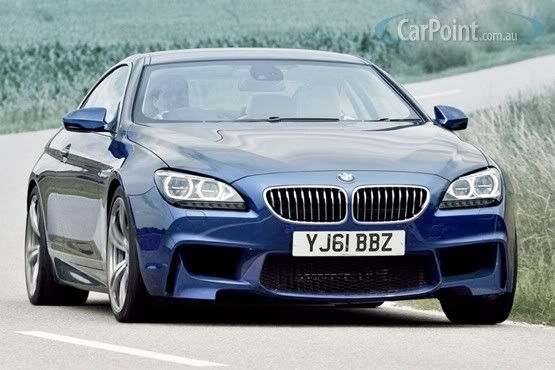BMW M6 and M6 Cabrio still a heavy hitter
M5's twin-turbo V8 delivers plenty of grunt in the 6 Series, despite a dry weight approaching two tonnes
Get the best price on a new BMW
If the M5’s four doors and sedan shape are just a bit too family for you, BMW believes it has a solution.
It has taken the predictable (but nonetheless effective) solution of stuffing the acclaimed M5’s twin-turbo V8 running gear inside the swoopier 6-Series body to create its new M6.
And it has taken the heavy hitting even further, evoking memories of the mega-quick M3 CSL by fitting the rear-wheel drive M6 Coupe with a lightweight carbon-fibre roof for its launch at this year’s Geneva Motor Show.
It promises to be the fastest M6 yet from the Bavarian power haus, with 412kW of power hurling the 5-Series-based two door to 100km/h in just 4.2 seconds on its way to an electronically limited top speed of 250km/h.
It won’t stop there, though, because European buyers will be able to unleash the M6’s full potential with the M Driver’s Package, which will add higher-speed tyres, remove the rev limiter and let it rip and tear its way to 305km/h. Either way, the big M6 Coupe will fling itself beyond 200km/h in just 12.6 seconds, which puts the 100km/h to 200km/h sprint down as an 8.4-second exercise. The Cabrio, meanwhile, is a tenth of a second slower to 100km/h, but half a second slower to 200.
It looks like a meaner, leaner 640i, with changes to the bootlid’s shape, the bonnet and a new, lower, three-section air intake up front meeting the wind. There is also a new kidney grille, now complete with an M6 badge inside it and surrounded by adaptive LED headlights, while the tail hosts a diffuser section framed by a four exhaust tips.
The M6 will be no lightweight, though, and is shaping up to be a specialist grand tourer rather than a track-day special. M has given the M6 twins aluminium doors, an aluminium bonnet, plastic front quarter panels and a glassfibre composite called SMC (sheet-moulded compound) for the bootlid. None of it has helped much, because even the relatively svelte coupe is 1850kg, and that’s before you put fluids in it. The Cabrio, meanwhile, is a full 110kg heavier.
Some (but not all) of that heft is due to strengthening bits that need to cope with the forces the engine and the 19-inch standard Michelins (or the optional 20-inch ones) punch through the 6-Series chassis.
The track widths have been stretched 30mm at both ends and the M6 receives enormous standard brakes, with 400mm front discs clamped by a six-piston caliper. The rear end copes with a 396mm disc (though sticks with a single-piston floating caliper), and it offers the undoubtedly expensive option of carbon-ceramic anchors that take the front disc size up to 410mm and save 19.4kg.
The heart of the mighty monster coupe is its 4.4-litre V8 heart. Twinned with the engine in the just-launched M5, the V8 carries its two twin-scroll turbo chargers inside its vee, uses direct fuel injection and inlet and exhaust valves that constantly vary their depth and timing.
It pumps out “surgency” from the instant the engine kicks over, with an astonishing 680Nm of torque on offer from as little as 1500rpm. That torque level stays at its high plateau until it finally begins to fade at 5750rpm, but by then the engine’s power has well and truly taken over. It, too, plateaus, so there is 412kW on offer from 6000 to 7000rpm, then the engine keeps spinning for another 200rpm before it hits its limiter.
That’s 30 percent more torque than the old V10 M6 and 10 percent more power, and BMW claims it will be enough to cover a standing kilometre in 21.9 seconds and it will burst from 80 to 120km/h in 3.6 seconds.
But it claims the M6 is also far more frugal, too, with 9.9 litres/100km for the combined cycle, thanks to start-stop, direct injection and active cooling, while the Cabrio clocks 10.3 litres. Both are 30 percent more efficient than their 10-cylinder predecessors.
It’s not, BMW insists, the same engine as it fits to the (even weightier) X6M and X5M. It uses trickier turbochargers that compress more air with less boost (0.9 bar versus 1.0), the XUV motor doesn’t have Valvetronic and there’s a larger diameter air intake.
While the engine’s block and crankcase is the same, the M6 (and M5) engine has a different exhaust manifold, different pistons, different electronics and a higher compression ratio, too. And there’s no differential stuck in the front of it.
It attaches to M’s seven-speed, double-clutch gearbox, which sits its clutch packs in an oil bath at the front of the gearbox. It includes built-in launch control, then hooks up to M’s active differential, which can switch from fully open to 100 per cent locked in an instant.
It picks up a lot of the M5’s other go-fast technology as well, including active damper control, and it also keeps the big sports sedan’s variable ratio hydraulic steering system in defiance of the trend to electric steering in mainstream BMWs.
Inside, the M6 will fairly drip in user-friendly bits and pieces, which might explain some of its weight problems. There will be a head-up display, night vision (with pedestrian recognition algorithms built in), a reversing camera, surround view cameras, lane departure warning systems and there is even space for a Bang and Olufsen surround sound system.





 Reply With Quote
Reply With Quote


 CL Champs 2019 for the 6th time
CL Champs 2019 for the 6th time 




Bookmarks